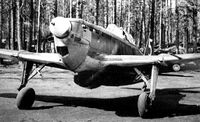Portal:Aurorum/Featured article: Difference between revisions
No edit summary |
No edit summary |
||
| Line 1: | Line 1: | ||
<div style="float:left;margin:0.5em 0.9em 0.4em 0;">[[File: | <div style="float:left;margin:0.5em 0.9em 0.4em 0;">[[File:J36_main_infobox.jpg|200px]]</div>The '''J 36 ''Falke''''' ("hawk") was a [[Melasia|Melasian]] {{wp|fighter aircraft}} of the first half of the 20th century. It was designed by Erich Krammer and produced by the Melasian aviation company Arsenal. The aircraft is remarkable for being Melasia's first domestically designed and produced fighter aircraft and the first non-Berean type of combat aircraft to exceed speeds of {{convert|400|km/h|kn|-2|sp=us|abbr=on}} in a straight level flight. The J 36 was of a mixed {{wp|semi-monocoque}} and {{wp|stressed skin}} design, built mostly of wood and fabric, with metal used in vital points of the structure like the engine cowling and the {{wp|rudder}} fin joint. It also had some advanced features for the period, like the retractable {{wp|landing gear}}, the completely enclosed {{wp|cockpit}} and the split {{wp|flaps}}. The high wingspan and the short fuselage provided a relatively small wing loading, while the light weight of the wooden construction coupled with a powerful V-12 engine allowed for a respectable degree of manoeuvrability.. ('''[[Arsenal J 36 Falke|See more...]]''') | ||
Revision as of 20:53, 25 May 2022
The J 36 Falke ("hawk") was a Melasian fighter aircraft of the first half of the 20th century. It was designed by Erich Krammer and produced by the Melasian aviation company Arsenal. The aircraft is remarkable for being Melasia's first domestically designed and produced fighter aircraft and the first non-Berean type of combat aircraft to exceed speeds of 400 km/h (200 kn) in a straight level flight. The J 36 was of a mixed semi-monocoque and stressed skin design, built mostly of wood and fabric, with metal used in vital points of the structure like the engine cowling and the rudder fin joint. It also had some advanced features for the period, like the retractable landing gear, the completely enclosed cockpit and the split flaps. The high wingspan and the short fuselage provided a relatively small wing loading, while the light weight of the wooden construction coupled with a powerful V-12 engine allowed for a respectable degree of manoeuvrability.. (See more...)
